toneeees
Administrator
- Joined
- Mar 15, 2011
- Messages
- 3,024
[FONT=Trebuchet MS, Lucida Grande, Arial, sans-serif]Yamaha and other engine manufacturers offer popular four-cylinder four-stroke outboards that are used in a wide range of single and multiple engine installation applications, in both fresh and saltwater. From pontoons to center consoles, bass boats to work skiffs and even water taxis, they are great performers and real workhorses. Many need to be taken out of service for the colder, winter season.[/FONT]
[FONT=Trebuchet MS, Lucida Grande, Arial, sans-serif]While there's definitely merit in having your outboard winterized by a certified local dealer, the process is simple enough for many owners to do themselves when armed with the right tools, products, and a bit of proper education. Pete Reils, a long-time certified Yamaha Technician at Garden State Marina in Pt. Pleasant, New Jersey, recently took the time to show us how he winterizes Yamaha outboards. The boat featured here is a late model Cobia? center console powered by a single Yamaha F150.[/FONT]
[FONT=Trebuchet MS, Lucida Grande, Arial, sans-serif]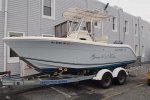 [/FONT]
[/FONT]
[FONT=Trebuchet MS, Lucida Grande, Arial, sans-serif]Prep Work
Prior to winterizing the outboard, it's a good idea to give the boat a good cleaning inside and out, power wash the bottom, and put a coat of wax on fiberglass hulls. http://www.iboats.com/Boat-Cleaners-Waxes/dm/view_id.217282[/FONT]
[FONT=Trebuchet MS, Lucida Grande, Arial, sans-serif]Before you get started, put together a checklist of everything you'll need, and be sure you have the proper lubricants, additives and filters for the job. (A list is available in your owner's manual and on most engine manufacturer's website).[/FONT]
[FONT=Trebuchet MS, Lucida Grande, Arial, sans-serif]Draining the Oil (see your owner's manual for your particular brand and model)
Pete's process starts with changing the crankcase oil. Place an oil pan under the lower unit and with the engine trimmed all the way up, remove the drain plug located inside the rubber tube below the rear of the cowling (most mid-range models). [Remember, Pete is working on a Yamaha Outboard, your engine may be different and require other steps to change the oil. Check your owner's manual for details.][/FONT]
[FONT=Trebuchet MS, Lucida Grande, Arial, sans-serif]Pete places a piece of plastic tubing as an extension over the rubber tube to direct the oil into the pan. Lower the engine using the trim switch on the starboard side to start the oil flowing. After the oil has finished draining, replace the gasket on the drain plug and re-install the drain plug, tightening to spec (see Owner's Manual).[/FONT]
[FONT=Trebuchet MS, Lucida Grande, Arial, sans-serif]Draining the Lower Unit
With the engine still down, slide an oil catch pan directly underneath the lower unit and remove both the vent screw and the drain screw on the starboard side of the lower unit to remove the old lubricant. Depending on the temperature of the air and the outboard, this may take a while. Be patient, until all the oil is drained. Check the old lubricant for any milky residue, which is an indication that water could be getting into the lower unit through a damaged seal. If this is found, it's time to contact your dealer for a seal replacement and a pressure test. Also, check for any large metal particles in the oil or adhering to the drain plugs (they're magnetic). This would be a reason to see your dealer, too.[/FONT]
[FONT=Trebuchet MS, Lucida Grande, Arial, sans-serif]The most common cause of lower unit water ingestion is discarded fishing line caught behind the propeller. While you're here, remove the propeller, remove any line or other debris, and grease the prop shaft to make prop installation and removal easier. If you store your boat in the open or a public storage facility you may want to take the prop off and store it in a safe place until you're ready to use it again.[/FONT]
[FONT=Trebuchet MS, Lucida Grande, Arial, sans-serif]Replacing the Oil Filter
While the gearcase is draining, remove the engine oil filter. On some Yamaha and other outboards, just be careful not to disturb the oil sensor located on the block just above the filter.[/FONT]
[FONT=Trebuchet MS, Lucida Grande, Arial, sans-serif]Lubricate the rubber gasket on the new filter with a little fresh engine oil to assure a proper seal, and then install by hand tightening the filter to specifications listed on the cowl of some engines or in your owner's manual.[/FONT]
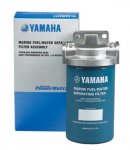 [FONT=Trebuchet MS, Lucida Grande, Arial, sans-serif]Refill the crank case with the proper amount of four cycle/stroke engine oil (see owner's manual). Don't over-fill.[/FONT]
[FONT=Trebuchet MS, Lucida Grande, Arial, sans-serif]Refill the crank case with the proper amount of four cycle/stroke engine oil (see owner's manual). Don't over-fill.[/FONT]
[FONT=Trebuchet MS, Lucida Grande, Arial, sans-serif]Filling the Lower Unit
Now it's time to refill the lower unit. You can use quarts and a hand pump available from your local dealer. Thread the fill hose into the drain plug hole and carefully pump in the lubricant until it starts weeping out of the upper vent. Pause for 5 minutes to allow all air to escape, then slowly pump additional lubricant until it comes out the vent hole again. Make sure to change the gaskets on both the vent and the drain plugs (do not reuse them). Make sure those gaskets are on the plug before you re-install them, without the plug water will weep into the gearcase and could cause significant damage to your lower unit.[/FONT]
[FONT=Trebuchet MS, Lucida Grande, Arial, sans-serif]Reinstall the vent plug until tight, then remove the fill hose from the bottom and reinstall the drain plug.[/FONT]
[FONT=Trebuchet MS, Lucida Grande, Arial, sans-serif]Fuel Filters
Now it's time to turn your attention to the fuel system. First, carefully remove the 10-micron fuel/water separating the filter located in the boat (Yamaha's is light blue) and discard filter and contents appropriate to your local regulations. Then, reinstall a new 10-micron canister, using another thin film of clean oil on the gasket surface.[/FONT]
[FONT=Trebuchet MS, Lucida Grande, Arial, sans-serif]Stabilizing the Fuel
There are several ways to make sure you stabilize your fuel for the off season. Many people use Sta-Bil and add the recommended amount directly to the fuel tank.[/FONT]
[FONT=Trebuchet MS, Lucida Grande, Arial, sans-serif] [/FONT]
[/FONT]
[FONT=Trebuchet MS, Lucida Grande, Arial, sans-serif]Add the Sta-Bil prior to your last boating event of the season so it is well mixed with the fuel and gets to all parts of the fuel system. Pete uses a portable fuel tank with a small amount of fresh gas treated with Yamalube? Ring Free and Yamalube Fuel Stabilizer & Conditioner. Start by placing a hose flusher over the main lower unit water pickups and turn on the water.[/FONT]
[FONT=Trebuchet MS, Lucida Grande, Arial, sans-serif]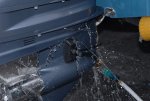 [/FONT]
[/FONT]
[FONT=Trebuchet MS, Lucida Grande, Arial, sans-serif]Disconnect the rubber fuel hose at the inlet side of the primary on-engine fuel filter by loosening the spring clamp with needle nose pliers and connect the hose from the portable tank. Pump a primer bulb installed in the portable tank's fuel line until firm and then start the engine, after turning on the water. Run it for 10 minutes at fast idle until the mixture is thoroughly distributed throughout the fuel system and combustion chambers. This lubricates the injectors, valves, cylinder walls and piston rings for the long storage period ahead.[/FONT]
[FONT=Trebuchet MS, Lucida Grande, Arial, sans-serif]Some engine manufacturers also recommend, after the engine cools, you remove the spark plugs, inspect and replace if necessary, and before re-installing the plug, spray a couple ounces of fogging oil into each cylinder. Install the spark plugs but not the spark plug wires, turn the engine over a couple times to spread the fogging oil throughout the cylinders and parts of the exhaust channels then firmly reattach the spark plug wires. Do not run the engine again until the new boating season.[/FONT]
[FONT=Trebuchet MS, Lucida Grande, Arial, sans-serif]When you're done, trim the engine fully "in" to drain the water from the cooling system and disconnect the onboard flushing hose so that it drains, too. Then reconnect.[/FONT]
[FONT=Trebuchet MS, Lucida Grande, Arial, sans-serif]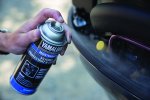 [/FONT]
[/FONT]
[FONT=Trebuchet MS, Lucida Grande, Arial, sans-serif]Don't Forget[/FONT]
[FONT=Trebuchet MS, Lucida Grande, Arial, sans-serif]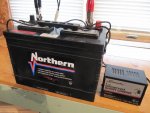 [/FONT]
[/FONT]
[FONT=Trebuchet MS, Lucida Grande, Arial, sans-serif]The typical Do-It-Yourself'er can usually complete the entire job in an hour or so. Just be sure you have all the supplies you need on hand and take your time, covering all the steps.[/FONT]
[FONT=Trebuchet MS, Lucida Grande, Arial, sans-serif]You'll find more information in Yamaha's comprehensive "Maintenance Matters" publication, available at your nearest Yamaha Marine dealer or online at maintenance.yamahaoutboards.com.[/FONT]
[FONT=Trebuchet MS, Lucida Grande, Arial, sans-serif]The threat of winter's first freeze is almost always too late. Taking time now helps ensure good times come spring.[/FONT]
[FONT=Trebuchet MS, Lucida Grande, Arial, sans-serif]While there's definitely merit in having your outboard winterized by a certified local dealer, the process is simple enough for many owners to do themselves when armed with the right tools, products, and a bit of proper education. Pete Reils, a long-time certified Yamaha Technician at Garden State Marina in Pt. Pleasant, New Jersey, recently took the time to show us how he winterizes Yamaha outboards. The boat featured here is a late model Cobia? center console powered by a single Yamaha F150.[/FONT]
[FONT=Trebuchet MS, Lucida Grande, Arial, sans-serif]
 [/FONT]
[/FONT][FONT=Trebuchet MS, Lucida Grande, Arial, sans-serif]Prep Work
Prior to winterizing the outboard, it's a good idea to give the boat a good cleaning inside and out, power wash the bottom, and put a coat of wax on fiberglass hulls. http://www.iboats.com/Boat-Cleaners-Waxes/dm/view_id.217282[/FONT]
[FONT=Trebuchet MS, Lucida Grande, Arial, sans-serif]Before you get started, put together a checklist of everything you'll need, and be sure you have the proper lubricants, additives and filters for the job. (A list is available in your owner's manual and on most engine manufacturer's website).[/FONT]
[FONT=Trebuchet MS, Lucida Grande, Arial, sans-serif]Draining the Oil (see your owner's manual for your particular brand and model)
Pete's process starts with changing the crankcase oil. Place an oil pan under the lower unit and with the engine trimmed all the way up, remove the drain plug located inside the rubber tube below the rear of the cowling (most mid-range models). [Remember, Pete is working on a Yamaha Outboard, your engine may be different and require other steps to change the oil. Check your owner's manual for details.][/FONT]
[FONT=Trebuchet MS, Lucida Grande, Arial, sans-serif]Pete places a piece of plastic tubing as an extension over the rubber tube to direct the oil into the pan. Lower the engine using the trim switch on the starboard side to start the oil flowing. After the oil has finished draining, replace the gasket on the drain plug and re-install the drain plug, tightening to spec (see Owner's Manual).[/FONT]
[FONT=Trebuchet MS, Lucida Grande, Arial, sans-serif]Draining the Lower Unit
With the engine still down, slide an oil catch pan directly underneath the lower unit and remove both the vent screw and the drain screw on the starboard side of the lower unit to remove the old lubricant. Depending on the temperature of the air and the outboard, this may take a while. Be patient, until all the oil is drained. Check the old lubricant for any milky residue, which is an indication that water could be getting into the lower unit through a damaged seal. If this is found, it's time to contact your dealer for a seal replacement and a pressure test. Also, check for any large metal particles in the oil or adhering to the drain plugs (they're magnetic). This would be a reason to see your dealer, too.[/FONT]
[FONT=Trebuchet MS, Lucida Grande, Arial, sans-serif]The most common cause of lower unit water ingestion is discarded fishing line caught behind the propeller. While you're here, remove the propeller, remove any line or other debris, and grease the prop shaft to make prop installation and removal easier. If you store your boat in the open or a public storage facility you may want to take the prop off and store it in a safe place until you're ready to use it again.[/FONT]
[FONT=Trebuchet MS, Lucida Grande, Arial, sans-serif]Replacing the Oil Filter
While the gearcase is draining, remove the engine oil filter. On some Yamaha and other outboards, just be careful not to disturb the oil sensor located on the block just above the filter.[/FONT]
[FONT=Trebuchet MS, Lucida Grande, Arial, sans-serif]Lubricate the rubber gasket on the new filter with a little fresh engine oil to assure a proper seal, and then install by hand tightening the filter to specifications listed on the cowl of some engines or in your owner's manual.[/FONT]
 [FONT=Trebuchet MS, Lucida Grande, Arial, sans-serif]Refill the crank case with the proper amount of four cycle/stroke engine oil (see owner's manual). Don't over-fill.[/FONT]
[FONT=Trebuchet MS, Lucida Grande, Arial, sans-serif]Refill the crank case with the proper amount of four cycle/stroke engine oil (see owner's manual). Don't over-fill.[/FONT][FONT=Trebuchet MS, Lucida Grande, Arial, sans-serif]Filling the Lower Unit
Now it's time to refill the lower unit. You can use quarts and a hand pump available from your local dealer. Thread the fill hose into the drain plug hole and carefully pump in the lubricant until it starts weeping out of the upper vent. Pause for 5 minutes to allow all air to escape, then slowly pump additional lubricant until it comes out the vent hole again. Make sure to change the gaskets on both the vent and the drain plugs (do not reuse them). Make sure those gaskets are on the plug before you re-install them, without the plug water will weep into the gearcase and could cause significant damage to your lower unit.[/FONT]
[FONT=Trebuchet MS, Lucida Grande, Arial, sans-serif]Reinstall the vent plug until tight, then remove the fill hose from the bottom and reinstall the drain plug.[/FONT]
[FONT=Trebuchet MS, Lucida Grande, Arial, sans-serif]Fuel Filters
Now it's time to turn your attention to the fuel system. First, carefully remove the 10-micron fuel/water separating the filter located in the boat (Yamaha's is light blue) and discard filter and contents appropriate to your local regulations. Then, reinstall a new 10-micron canister, using another thin film of clean oil on the gasket surface.[/FONT]
[FONT=Trebuchet MS, Lucida Grande, Arial, sans-serif]Stabilizing the Fuel
There are several ways to make sure you stabilize your fuel for the off season. Many people use Sta-Bil and add the recommended amount directly to the fuel tank.[/FONT]
[FONT=Trebuchet MS, Lucida Grande, Arial, sans-serif]
 [/FONT]
[/FONT][FONT=Trebuchet MS, Lucida Grande, Arial, sans-serif]Add the Sta-Bil prior to your last boating event of the season so it is well mixed with the fuel and gets to all parts of the fuel system. Pete uses a portable fuel tank with a small amount of fresh gas treated with Yamalube? Ring Free and Yamalube Fuel Stabilizer & Conditioner. Start by placing a hose flusher over the main lower unit water pickups and turn on the water.[/FONT]
[FONT=Trebuchet MS, Lucida Grande, Arial, sans-serif]
 [/FONT]
[/FONT][FONT=Trebuchet MS, Lucida Grande, Arial, sans-serif]Disconnect the rubber fuel hose at the inlet side of the primary on-engine fuel filter by loosening the spring clamp with needle nose pliers and connect the hose from the portable tank. Pump a primer bulb installed in the portable tank's fuel line until firm and then start the engine, after turning on the water. Run it for 10 minutes at fast idle until the mixture is thoroughly distributed throughout the fuel system and combustion chambers. This lubricates the injectors, valves, cylinder walls and piston rings for the long storage period ahead.[/FONT]
[FONT=Trebuchet MS, Lucida Grande, Arial, sans-serif]Some engine manufacturers also recommend, after the engine cools, you remove the spark plugs, inspect and replace if necessary, and before re-installing the plug, spray a couple ounces of fogging oil into each cylinder. Install the spark plugs but not the spark plug wires, turn the engine over a couple times to spread the fogging oil throughout the cylinders and parts of the exhaust channels then firmly reattach the spark plug wires. Do not run the engine again until the new boating season.[/FONT]
[FONT=Trebuchet MS, Lucida Grande, Arial, sans-serif]When you're done, trim the engine fully "in" to drain the water from the cooling system and disconnect the onboard flushing hose so that it drains, too. Then reconnect.[/FONT]
[FONT=Trebuchet MS, Lucida Grande, Arial, sans-serif]
 [/FONT]
[/FONT][FONT=Trebuchet MS, Lucida Grande, Arial, sans-serif]Don't Forget[/FONT]
- [FONT=Trebuchet MS, Lucida Grande, Arial, sans-serif]Tilt the engine up and use a grease gun to lubricate all grease fittings. There is one on each side of the steering slide forward of the engine, another found on the steering column, and one on the shift mechanism where the shift cables enter the cowling.[/FONT]
- [FONT=Trebuchet MS, Lucida Grande, Arial, sans-serif]Spray the engine and rubber components with a liberal application of Yamalube? Silicone Engine Protectant and Lubricant or YamaShield. Once the boat gets to its final winter resting spot, trim the engine full "in" for storage and disconnect the negative battery cable(s).[/FONT]
- [FONT=Trebuchet MS, Lucida Grande, Arial, sans-serif]Remove the battery or batteries to a cool (but not freezing), dry place. Charge the battery fully before storage. (some battery manufacturers recommend removing the battery and storing it while connected to a trickle charger).[/FONT]
- [FONT=Trebuchet MS, Lucida Grande, Arial, sans-serif]Return the cowling to its proper position and your outboard should be ready for winter storage and start up in the spring.[/FONT]
[FONT=Trebuchet MS, Lucida Grande, Arial, sans-serif]
 [/FONT]
[/FONT][FONT=Trebuchet MS, Lucida Grande, Arial, sans-serif]The typical Do-It-Yourself'er can usually complete the entire job in an hour or so. Just be sure you have all the supplies you need on hand and take your time, covering all the steps.[/FONT]
[FONT=Trebuchet MS, Lucida Grande, Arial, sans-serif]You'll find more information in Yamaha's comprehensive "Maintenance Matters" publication, available at your nearest Yamaha Marine dealer or online at maintenance.yamahaoutboards.com.[/FONT]
[FONT=Trebuchet MS, Lucida Grande, Arial, sans-serif]The threat of winter's first freeze is almost always too late. Taking time now helps ensure good times come spring.[/FONT]



















